Into the next era: Colorado School of Mines building on a legacy of confronting challenges
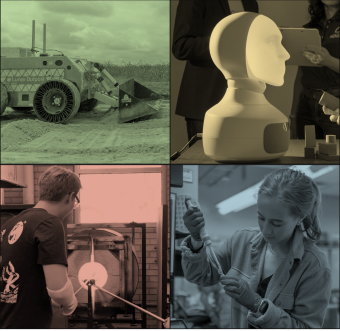
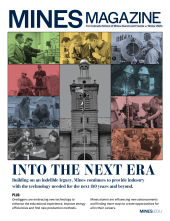
By Jen A. Miller, Special to Mines Magazine
When Mines first opened in 1874, Colorado was still a territory and the course of study was narrow: on gold and silver, and the knowledge and skill in mining, geology, chemistry and more needed to support the extraction and refinement of the precious metals.
As the school became a college then a university, its focus expanded to understanding the Earth, harnessing energy, sustaining the environment and more.
Now, 150 years later, Mines has a diverse array of degree programs at the undergraduate and graduate levels and continues to grow and evolve to meet industry needs, innovate in emerging areas of technology and prepare graduates to lead the way in continuing to solve the world’s most pressing challenges.
“Mines is always working to position itself, not only to maintain the role it’s been playing in higher education for 150 years but also to expand and adapt as the world is changing,” said Sam Spiegel, assistant vice president of online education at Mines.
That means constantly and consistently speaking with alumni, industry leaders and policymakers about what they see as vital educational components. As a result, Mines graduates are prepared for the workforce they will enter and grow into and have the tools to become its leaders in due time. “Future proofing” a career isn’t just a concept at Mines—it’s reality.
That includes meeting students where they are and creating learning opportunities that match how they can best learn and be part of the Mines community, such as offering online courses and expanding degree offerings into new areas.
“Online education gives Mines an opportunity to reach student populations that we normally wouldn’t have been able to access—and do so easily,” Spiegel said. “It breaks down geographical as well as some of the time barriers that might have kept students from studying here.”
That’s to the benefit of Mines students and beyond. In Spring 2024, Mines is launching new, expanded short courses, workshops and boot camps with a large library of self-study, self-paced modules and workshops. This means that working professionals can access this critical information on their own schedule instead of having to attend a live seminar set at a fixed time and date.
“This allows us to focus on adaptable learning opportunities that are condensed and very targeted to current and future needs of industry,” Spiegel said.
But offering online education opportunities is just one part of the equation. With new degree programs and expanded emphasis areas, Mines is also positioning itself to be a key player in the future of several growing industries to solve emerging challenges and train skilled engineers and scientists to lead this future. Here are just a few examples.
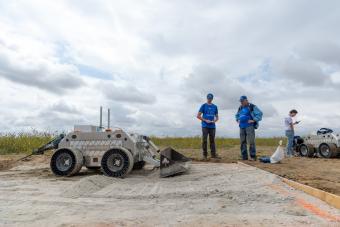
Emerging trends beyond our atmosphere
While Mines started its mission focused on understanding the Earth, that mission, much like human exploration, has expanded up—way up—to space and beyond.
From contributing to projects such as the Moon landing and the Mars Curiosity Rover, Mines has continued to pave the way to space exploration—and space living. Mines’ Space Resources program, with the Center for Space Resources, grew out of this work to meet the demand for resources to further our knowledge and exploration in this area. It was the first program in the world focused on educating scientists, engineers, economists, entrepreneurs and policymakers in developing the field of space resources.
And that work continues and is growing faster than ever. Through the Artemis V program, NASA is preparing to send people back to the Moon and build a base camp there, and private investment in space exploration is expanding the idea of who is going into space. Getting to Mars is not outside the realm of possibility either.
“It’s human evolution to keep expanding and growing and exploring,” said Bailey Burns ’18, MS ’21, an aerospace systems engineer at Blue Origin. The company is building a lunar crew lander for Artemis, and she’s working on ways to make life easier and more comfortable for astronauts. “As we evolve, we need to figure out how to do things more efficiently, and through exploration, that is what space is forcing us to do.”
Figuring out how to live and explore in space benefits life on Earth, too. Research on “how we keep human consumables in space clean so we don’t have to keep shipping water and oxygen from Earth will directly play into climate change and how to be more sustainable,” Burns, who has also participated in two simulated space missions to get a better understanding of what that kind of confined living experience is like, said. “There’s a lot of progress that’s happening on Earth that space will also force us to do, sometimes even faster. It expedites that development on how to be better human beings to our home planet.”
The kind of education Mines provides, which is focused on technical skills but also problem solving, makes it an ideal institution to continue to lead in this field, Burns said, because space presents new problems that people will have to solve by working together. For example, uncrewed projects to Mars have sent back reams of data about the journey there and conditions on Mars to prepare for crewed missions. But it’s still unknown territory and unknown problems will unfold, in both getting people there and keeping them alive when they arrive.
That kind of handling of uncertainty, through teamwork, is what Mines prepares its students for. Burns cites an old adage to show why: “If you want to go fast, you go alone. And if you want to go far, you go together,” she said. “Mines is teaching engineers how to go together.”
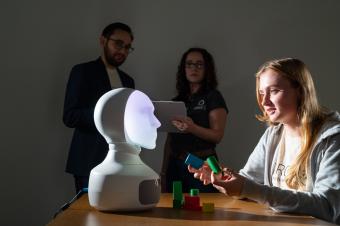
Advancements in robotics and AI to improve lives
Robotic technology and artificial intelligence are becoming part of everyday life, and the technology is becoming more and more advanced. Today, these technologies are helping with everything from voice-activated assistants to enabling faster supply chains and getting online deliveries to homes quickly, rapidly changing day-to-day processes and systems.
“There are so many opportunities in automation and AI and machine learning,” said Elissa Himes ’21, MS ’22, a robotics simulation engineer at The Toro Company, which makes lawn, snow and irrigation technologies for the private, public, commercial and agricultural sectors. “It’s more prevalent in everything that we do.”
And she truly means everything—from enabling voice-powered assistants to powering autonomous forklifts to making manufacturing lines more efficient.
According to the Industrial Robotics Federation, 553,052 new industrial robots were installed in 2022, an all-time high. The group expects that number to cross the 600,000 mark in 2024. The future of robotics is inextricably tied to that of artificial intelligence, as robots are often called “embodied AI,” according to global consultancy EY.
And while AI is not new, it’s reaching new heights. Large language model ChatGPT had one million users within its first five days of launch—it now has more than 100 million. A report from Forbes Advisor found that 64 percent of businesses expect AI to improve productivity. Overall, the AI market overall is expected to hit $207 billion by 2027, according to research group MarketsandMarkets.
Because the potential in robotics and AI is seemingly limitless, industry needs skilled engineers in all industries who can approach the challenges, and potentials, of both technologies, from all angles. For example, Himes is working on creating simulations for an autonomous lawn mower, which feels like a normal extension of robotics and AI to anyone who’s seen a Roomba, but would most likely not have been in the wildest dreams of J.S. Clapper, president of what was then called the Toro Motor Company in 1914.
And future advances may be surprising, but Mines graduates are taught to lead the way, whatever those ways may be. Moving ahead with exploration and development of robotics and AI is going to take professionals who understand the capabilities, potential and implications of what they can do, which Mines provides.
“Mines prepared me in terms of how to figure stuff out,” Himes said, which is critical to her current project. She also was able to structure her master’s degree so she could take classes in “everything I possibly could,” she said. “Robotics is such a broad area, and it gave me an idea of what I wanted to focus on. When I hear certain terms, I can at least say, ‘Oh yeah I know a little bit about that,’ and I know where to start looking.”
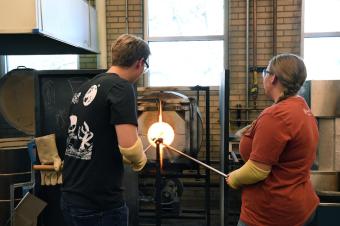
Ceramics enable new technology and capabilities
While most people first associate ceramics with basic porcelain, pottery and dinnerware, it’s also a vital material in the manufacturing and industrial realms and is part of everything from semiconductors to petroleum refining processes.
Ceramics are so malleable and adaptable to so many situations that the material will continue to be key in technological advancements. They fill in gaps where materials common in industry production or products don’t work.
“Customers usually come to us after they’ve tried plastics, after they’ve tried metals and they don’t work,” said Timothy Coors ’01, CEO of CoorsTek, a company that specializes in engineered technical ceramics. “Some need our material to be electrically conductive, or some need it electrically isolating. Some need it to be harder, some need it to be temperature resistant.
“Why do bakers bake so many types of bread?” he added. “Being able to alter the recipe, we’re able to get harder materials, we’re able to get materials that are able to flex, we’re able to get materials that withstand higher temperatures versus lower temperatures. It’s almost endless.”
By changing the make-up of the actual ceramic, a material can become that missing component and either solve a problem or open the door to new potential.
As such, the global ceramics industry is expected to be worth $219.12 billion by 2028, according to Fortune Business Insights.
As a response to this growing industry and the need for highly skilled engineers in the field, Mines launched a new Bachelor of Science in Ceramic Engineering program in Fall 2023, which was developed in consultation and partnership with industry experts and partners, like CoorsTek. In addition to enabling the construction of the CoorsTek Center for Applied Science and Engineering on the Mines campus and investing in a research partnership with the school, CoorsTek also endowed graduate research fellowships in ceramics at Mines to propel this work forward.
“Mines goes beyond producing exceptional careers—it cultivates individuals capable of independent thinking. These engineers don’t just solve problems, they proactively identify them. They evolve into leaders who actively contribute to shaping tomorrow,” Coors said of the reasons CoorsTek has invested in this area at Mines and for providing unique opportunities for those in the fellowship program.
Fifteen doctoral candidates have benefitted from the fellowship program since its inception, working with state-of-the-art equipment and world-renowned Mines faculty and engineers and scientists from CoorsTek to create the next generation of high-performance materials to enable new technologies and possibilities in industry.
“As engineers and creators keep exploring and keep creating, we continue to push the boundaries of science in general but particularly material science,” Coors said, adding that we’re already beginning to realize the benefits of what these advances can do, especially when it comes to the automotive industry.
“If we think about electric vehicles 20 years ago, you could create one but it just wasn’t practical because the batteries were too big,” he said. “As battery sizes are coming down and the capacity of those batteries increase, it’s a material science challenge on display for all of us to see. Those things are happening in real time right in front of us.”
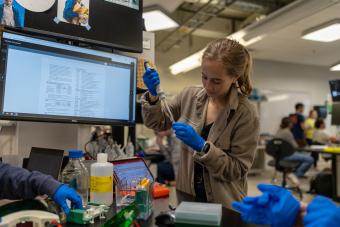
Personalizing, and smarting up, medicine through engineering
Some of the most transformative science and discovery happens at the intersections of biology and the mathematical, computational and engineering sciences. Whether it’s advancements in oncology, immunology, genetics and more, the possibilities are seemingly endless for skilled engineers in the field.
In Fall 2021, Mines launched a new undergraduate degree in Quantitative Biosciences and Engineering, which is training the next generation of engineers who are skilled in the intersections of biology and the mathematical, computational and engineering sciences.
Having a combination of these skills is necessary to keep pushing the field forward, because the next generation of medical advances can’t come from doctors and medical researchers alone.
That’s because personalized, tailored treatments, where what treatments will or won’t work is determined by studying each individual rather than treatments that apply to everyone, isn’t just fantasy. It’s now reality, thanks in part to more expertise and advancements in bioscience technology, said Bob Reddy ’95, vice president of global marketing for medical device company Medtronic.
These technologies are making surgeries quicker, safer and more precise. Technology is also being added to optimize devices that are already common in medical practice. “The miniaturization of technology is allowing for us to move forward and put sensors into smaller spaces that are then implanted into the body,” Reddy said.
For example, pacemakers can now tell healthcare providers that a battery needs to be replaced or that a lead is misfiring. These kinds of implants “can now be a smart implant to give information back,” he said.
In the future, patients with hydrocephalus, a condition where cerebrospinal fluid doesn’t drain from the brain properly, can have smart-enabled cerebral shunt implant. Patients or their parents can check on their implant themselves instantly to make sure it’s still working properly.
With more skilled engineers that specialize in this area, the growth in these kinds of technologies and the industry itself could be exponential. And Mines is key in leading this future because of how students are taught to work through problems.
“It’s not always about you personally solving a problem, but it’s about you working with a network of colleagues or employees at hand,” Reddy said. “There’s a bit of resilience that Mines teaches you, that no problem is too big. It might just take a little bit more time. You keep going after things."




